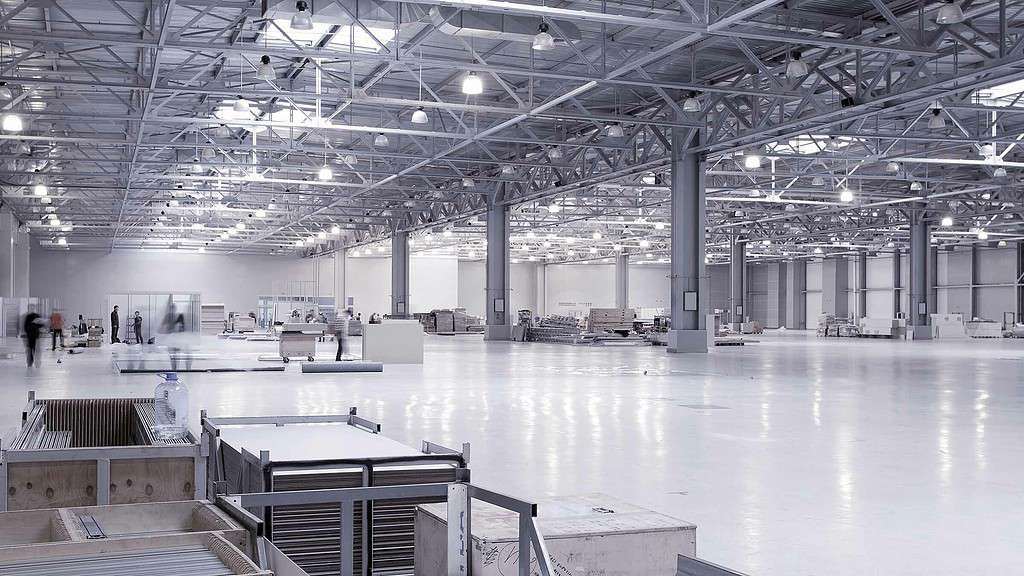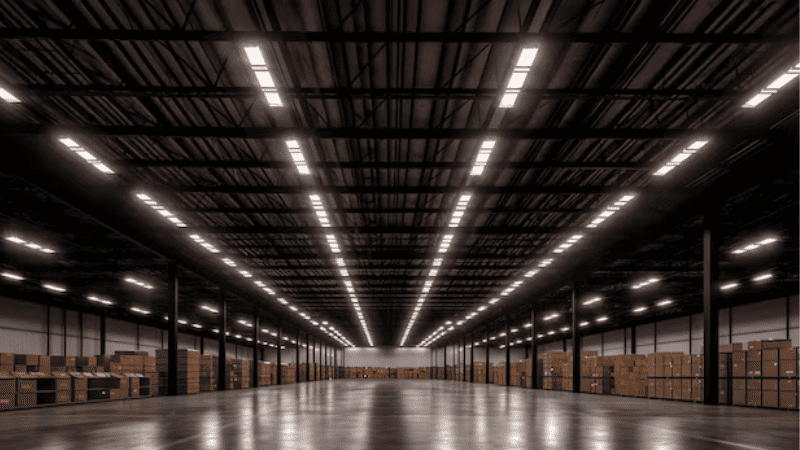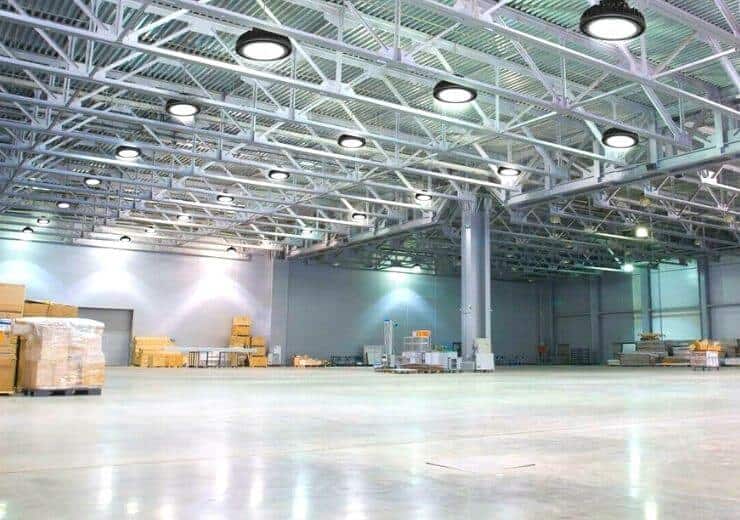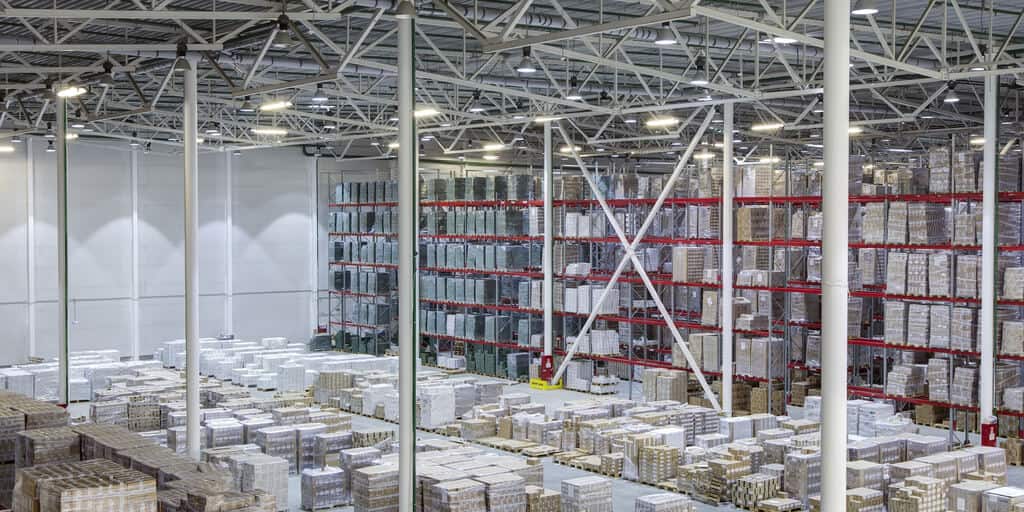Good lighting isn’t just about visibility, but it’s a gateway to working efficiently and safely and conserving electricity. But as businesses change, so do their lighting needs. There’s a debate between UFO lights and linear lights. So, which one is better for modern warehouses?

This article looks closely at warehouse lighting and compares UFO and linear lights. By the end, you’ll be equipped with the knowledge to make an informed decision, ensuring your warehouse isn’t just well-lit but also energy-efficient and future-ready.
The Importance of Warehouse High Bay Lighting
Here’s why picking the perfect lighting for warehouses is crucial:
1. Safety First
Good lighting is synonymous with safety. When every nook and cranny is visible, the chances of mishaps plummet. No one wants to trip over a misplaced box or strain their eyes trying to read a label. Proper lighting ensures that such issues are a rarity.
2. Elevated Productivity
Think about it – when you can see better, you work better. A well-illuminated warehouse means employees can find items faster, read labels without squinting, and confidently move around. The result? Tasks get done quicker and with fewer errors.
3. Economic Sense
Modern lights, especially LEDs, are kind to your pockets in the long run. They sip rather than gulp electricity and have a longer lifespan, meaning fewer replacements and lower bills. Plus, with the world moving towards eco-friendly solutions, energy-efficient lighting is a step in the right direction.
Ask For Free Quote
Let us Respond Promptly for your Needs :)
4. A Happier Workspace
A bright space uplifts the mood. Employees working in a well-lit environment reduce strain and discomfort, leading to a happier and more motivated workforce.
5. Staying Within the Rules
There are bodies like OSHA that lay down guidelines for warehouse lighting. Adhering to these ensures you’re on the right side of the law and that your warehouse is safe.
6. Specialized Lighting for Special Tasks
Some tasks need a bit more light. It could be reading the fine print or inspecting a product closely. Task-specific lighting ensures that such activities aren’t just doable but easy.
What Is UFO Lights
UFO LED high bay lights, aptly named for their distinct UFO-like shape, are becoming increasingly popular in commercial and industrial settings. These lights are designed for high ceiling heights, such as warehouses, factories, and shopping malls. Their unique shape allows them to cast a wide and even light distribution, making them ideal for illuminating large areas.
The design of UFO high bay light is not just about aesthetics. Their compact, round shape makes them durable and resilient, especially in environments prone to dust, moisture, or other challenging conditions. This resilience is further enhanced when the lights are made with materials like aluminum, known for its excellent heat dissipation properties.

Benefits of UFO Lights
- Energy-Efficient: UFO LED high bay lights don’t just light up spaces; they use way less energy than the old-school lights we’re used to. What does that mean for you? Well, a friendlier electricity bill, for starters.
- Built to Last: Ever want to change out bulbs? UFO lights feel you. These bad boys are in it for the long haul. They’re like the marathon runners of lights, built tough to handle the heat and the occasional bump or shake. So, in a bustling warehouse, they’re just what the doctor ordered.
- Bright Shine: These lights don’t just glow; they dazzle. They spread light evenly, ensuring every corner of your space is well-lit. Plus, they’re so good at showing true colors, making life easier for workers who need to spot details.
- Flexibility: Here’s the cool part – UFO lights aren’t just for warehouses. They’re like that versatile jacket for a night out and a casual brunch. Factories, retail spaces, and these lights blend right in. And with options to tweak their settings, they’re a lighting dream come true.
Disadvantages of UFO Lights
- Heat Dissipation Concerns: UFO LED High Bay Lights still generate heat despite cold light sources. When electricity is converted into light energy, a portion is converted into heat energy. Poor heat dissipation can lead to rapid increases in the junction temperature of the LED chip. If the UFO light operates at high temperatures for extended periods, its lifespan can be significantly reduced. Over time, this can lead to performance degradation and a shortened service life.
- Glare Issues: One of the significant drawbacks of UFO-style high bays is the potential for glare. Emitting light from a single, concentrated point can create glare, especially in environments where workers frequently look upwards. This glare can be distracting and even hazardous, particularly during tasks that require precision.
- Material Deformation: LED lights consist of various components made from different materials. When exposed to elevated temperatures, some materials might bend due to overheating. If components are closely packed, they might even damage each other.
What Is Linear Lights
Linear lighting, as the name suggests, is characterized by its elongated shape. Instead of the traditional round or square forms, linear lights often resemble lines or strips. Imagine light channels, tubes, or even strip lights; that’s linear lighting for you. The design is based on a line or rectangle, ensuring a broad light distribution.

Benefits of Linear Lights
- Wide Light Spread: One of the primary advantages of linear lights is their ability to illuminate vast spaces efficiently. This is especially beneficial in large areas like industrial halls and warehouses where consistent lighting is crucial for operations.
- Flexibility: Linear high bay lights can be connected and extended, offering a seamless lighting solution for extended areas.
- Efficiency: Despite their expansive light spread, linear lights generate a significant stream of light even at low power. This means you get more light for less energy.
- Durability: These lights are designed to withstand harsh working conditions. They resist frequent switching on and off and can handle varied temperatures, making them ideal for industrial settings.
Disadvantages of Linear Lights
- Not Eco-Friendly: While linear fluorescents light up spaces beautifully, they’re not the greenest choice. Unlike their LED siblings, they have a touch of mercury. If one breaks or isn’t tossed out right, it’s not just Mother Earth at risk – it’s also a safety hiccup for those working in the warehouse.
- Not Always the Brightest Bulb: Linear lights might not always shine as brightly as needed in such vast spaces. They’re great for even lighting, but when you need strong, focused lighting, they need to catch up.
- Create Shadows: It’s ironic, but these lights, known for their even glow, can sometimes cast shadows, especially if there’s something in their way. In a place where every detail counts, like a warehouse, shadows can be more than just a nuisance; they can lead to mistakes or even mishaps.
- Delicate: Linear lights, particularly the fluorescent ones, aren’t the toughest kids on the block. Compare them to the sturdy UFO lights, which might seem fragile. Accident bumps or knocks are always risky in a busy warehouse, where things move fast. And with these lights, that could mean breakages.
Ask For Free Quote
Let us Respond Promptly for your Needs :)
Comparing UFO vs Linear Lights for Warehouses
Both have their merits, but how do they stack up in terms of cost over their lifespan, versatility, performance metrics, and user feedback? Let’s dive in.
1. Cost Analysis Over Lifespan
UFO lights, with their round design and powerful beams, are known for their durability and aesthetic appeal in modern applications. They are compact, don’t require reflectors, and have a design that dissipates heat effectively, ensuring a longer lifespan. This means fewer replacements and maintenance costs over time.
On the other hand, Linear LED high bay light, with their elongated diode arrangement, can produce a wider beam angle. They are designed for maximum light output, ideal for vast spaces like warehouse aisles or other narrow areas. The LED technology in these lights is advanced, offering more than 90% energy efficiency. This translates to significant savings on electricity bills over their lifespan.

2. Adaptability to Changing Warehouse Layouts
Warehouse layouts are ever-evolving, and the lighting should be able to adapt to these changes. UFO lights, with their conical beam (usually 120 or 90 degrees), are more focused and controllable regarding light distribution. However, if they are spaced too far apart, there might be “white spots” that the conical beam can’t reach. This makes them more suited for open spaces without specific lighting requirements.
Linear lights, in contrast, project rectangular beams, making them perfect for areas like aisles and long benches. Their design ensures uniform light distribution, even in spaces limited by large shelves or where aisles form tunnels inside the warehouse. This uniformity means fewer shadows and better visibility, irrespective of how the warehouse layout changes.
3. User Feedback
Users often appreciate UFO lights’ powerful brightness. The wide beam angle is particularly praised for effectively illuminating larger areas. The advanced heat dissipation technology also gets a nod for ensuring the lights last longer, reducing the frequency of replacements.
As for the linear lights, users often commend these lights for their uniform and widespread distribution. The ease of installation and the ability to scale the lighting setup as per requirements are also frequently highlighted. The energy efficiency of these lights, leading to cost savings, is another aspect that users appreciate.
|
Criteria |
UFO Lights |
Linear Lights |
|
Cost Analysis Over Lifespan |
● Durable and aesthetically appealing ● Fewer replacements due to longer lifespan ● Reduced maintenance costs |
● Over 90% energy efficiency ● Significant savings on electricity bills |
|
Adaptability to Layouts |
● Suited for open spaces ● Might have “white spots” if spaced too far apart |
● Perfect for aisles and long benches ● Uniform light distribution, even with layout changes |
|
Performance Metrics |
|
|
|
Intensity and Coverage |
High-intensity illumination with wide beam angles |
Even illumination throughout the warehouse |
|
Heat Management |
Efficient heat dissipation technology |
Advanced LED technology |
|
Flexibility |
Versatile mounting options |
Modular design for scalability |
|
User Feedback |
|
|
|
Brightness |
Users appreciate the powerful brightness and wide beam angle |
Users commend the uniform and widespread lighting distribution |
|
Lifespan and Maintenance |
Praised for longer lifespan and reduced frequency of replacements |
Appreciated for ease of installation and scalability |
|
Energy Efficiency |
Standard energy efficiency |
Championed for consuming less power, leading to significant cost savings |
How to Choose the Right Lighting for Warehouses
Lighting in your warehouse is crucial as it can significantly impact worker productivity while minimizing errors and accidents. Here are four factors to consider when selecting the lighting for your warehouse.
1. Understand Your Warehouses Specific Requirements
It’s imperative to note that different areas within your warehouse may have lighting needs based on their function, layout, and workflows. For example, a packing area may demand more lighting compared to a storage area. It is vital to assess the requirements of each section of your warehouse to ensure the best possible lighting.
2. Consider Costs and Efficiency
Lighting costs can be substantial for warehouse operations. While options like LEDs are more energy efficient and may have costs, they ultimately save money in the long run due to lower power bills.
Conversely, traditional options such as incandescent or fluorescent lights might be cheaper initially. They consume less energy and require frequent replacements. Weighing the long-term costs and benefits of each option is crucial to make an informed decision.
3. Give Priority to Safety
Ensuring the safety of your warehouse employees relies heavily on lighting practices. Regular audits should be in place to identify areas or zones lacking lighting. Creating a strategy for the upkeep, repairs, and replacements necessary to uphold warehouse safety standards is highly advisable.

4. Adhere to Lighting Standards
The Occupational Safety and Health Administration (OSHA) and other organizations like the American National Standard Institute (ANSI) and Illuminating Engineering Society (IES) provide guidelines and standards for industrial lighting. These standards offer recommendations based on the work type and ensure adequate lighting. Adhering to these standards ensures compliance and guarantees that your warehouse is optimally lit for all operations.
Remember, the right lighting can significantly affect your warehouse operations’ efficiency and safety. Always consider the unique needs of your facility and consult with lighting experts if necessary to make the best choices.
Conclusion
Picking the right lights for your warehouse isn’t just about making everything bright and shiny. It’s about ensuring everyone can work safely, efficiently, and happily. Whether leaning towards the UFO lights for their power or the linear ones for their even glow, remember to factor in your warehouse’s unique vibe and needs. And, as you continue to tweak and transform your space, keep diving into the wealth of knowledge we’ve got here. Because when it comes to lighting up your warehouse, every little insight helps.
Experience Tomorrow’s Illumination with RC Lighting Solutions
Are you in search of an innovative and efficient Warehouse lighting solution that aligns perfectly with your requirements? Dive into the world of RC Lightning where we promise not just high-quality lighting fixtures, but also timely delivery and budget-friendly options. Contact us now for a free quote.



